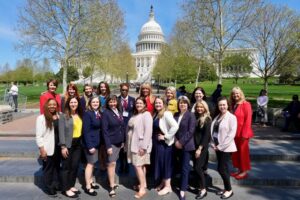WASHINGTON – The Federal Motor Carrier Safety Administration Wednesday published a notice of proposed rulemaking (NPRM) on changes to Hours of Service rules to what the agency said would increase safety on America’s roadways by updating existing regulations for commercial motor vehicle drivers.
“This proposed rule seeks to enhance safety by giving America’s commercial drivers more flexibility while maintaining the safety limits on driving time,” said U.S. Transportation Secretary Elaine L. Chao.
“FMCSA wants drivers and all CMV stakeholders to share their thoughts and opinions on the proposed changes to hours of service rules that we are putting forward today. We listened directly to the concerns of drivers for rules that are safer and have more flexibility—and we have acted. We encourage everyone to review and comment on this proposal,” said FMCSA Administrator Raymond P. Martinez.
First adopted in 1937, FMCSA’s Hours of Service rules specify the permitted operating hours of commercial drivers. In 2018, FMCSA authored an Advanced Notice of Proposed Rulemaking (ANPRM) to receive public comment on portions of the HOS rules to alleviate unnecessary burdens placed on drivers while maintaining safety on our Nation’s highways and roads. In response, the agency said it received more than 5,200 public comments.
Based on the detailed public comments, FMCSA’s proposed rule on Hours of Service offers five key revisions to the existing HOS rules:
- The agency proposes to increase safety and flexibility for the 30 minute break rule by tying the break requirement to eight hours of driving time without an interruption for at least 30 minutes, and allowing the break to be satisfied by a driver using on duty, not driving status, rather than off duty.
- The agency proposes to modify the sleeper-berth exception to allow drivers to split their required 10 hours off duty into two periods: one period of at least seven consecutive hours in the sleeper berth and the other period of not less than two consecutive hours, either off duty or in the sleeper berth. Neither period would count against the driver’s 14-hour driving window.
- The agency proposes to allow one off-duty break of at least 30 minutes, but not more than three hours, that would pause a truck driver’s 14-hour driving window, provided the driver takes 10 consecutive hours off-duty at the end of the work shift.
- The agency proposes to modify the adverse driving conditions exception by extending by two hours the maximum window during which driving is permitted.
- The agency proposes a change to the short-haul exception available to certain commercial drivers by lengthening the drivers’ maximum on duty period from 12 to 14 hours and extending the distance limit within which the driver may operate from 100 air miles to 150 air miles.
The NPRM drew positive reactions from three associations and negative reactions from both the Teamsters Union and the Advocates for Highway and Auto Safety.
“We applaud the agency’s efforts to create safety-first, data-driven regulations,” said Truckload Carriers Association President John Lyboldt. “The initiative to reduce roadway fatalities represents an industry lift for which TCA is committed to uniting with our federal agency partners.”
TCA Chairman Josh Kaburick said that with the publication of the NPRM the FMCSA is taking a much-needed step forward to establish added flexibility for drivers.
“We as an industry applaud Administrator Martinez and his staff for these efforts,” Kaburick said. “Now is the time for the industry to actively comment and provide data to justify full sleeper berth flexibility. Only through full flexibility will our drivers truly be in control of their day and provided the opportunity to sleep when needed or take a break to avoid excessive traffic congestion.”
“Secretary Chao and Administrator Martinez are to be commended for their commitment to an open and data-driven process to update the Hours of Service rules,” said ATA President and CEO Chris Spear. “We look forward to studying and understanding how these proposed changes will impact our industry so we can provide relevant data and information to strengthen and support a good final rule that bolsters safety and provides drivers needed flexibility. ATA intends to fully review these proposed changes so we can shape a strong rule for our drivers, our industry and the motoring public.”
“In the 15 years since the last major revisions to the hours-of-service, we as an industry have learned a great deal about how these rules impact our drivers,” said ATA Chairman Barry Pottle, president of Pottle’s Transportation. “The valuable experience and data we’ve gained over that time will make it easier to provide flexibility for drivers to get additional rest and find parking while keeping our highways safe.”
Owner-Operator Independent Drivers Association President Todd Spencer called thec proposal a common-sense approach.
“Truckers have families and want to get home safely just like everyone else. They are the most knowledgeable, highway safety advocates and the agency’s proposal, overall, recognizes that fact,” Spencer said. “Over the past decade, truck drivers have been more regulated than ever, and more compliant than ever, and yet crashes are going up,” said Spencer. “We have pushed for flexibility in hours of service regulations for years, long before the current Administration. We do thank Administrator Ray Martinez for his commitment to the issue and for listening to those that actually drive trucks for a living.”
Meanwhile, Teamsters General President Jim Hoffa said the proposed rules would put road safety at risk and that the union has serious concerns about the proposed changes.
“In an effort to increase so-called ‘flexibility’ for trucking companies, the FMCSA is abandoning safety and allowing drivers to push themselves to the limit even further,” Hoffa said. “Changes for short-haul truckers, for example, would extend their days from 12 to 14 hours on the job. That means a longer and more exhausting workday for tens of thousands of American workers. The Teamsters are also concerned about language changing the 30-minute rest break and the ability of drivers to press the pause button on their hours of service clock.”
Hoffa said trucking is already one of the nation’s most dangerous jobs.
“We shouldn’t be sacrificing the health and safety of drivers just to pad the profits of their big business bosses,” he said.
“Advocates for Highway and Auto Safety is staunchly opposed to the proposed changes in the NPRM which would significantly weaken HOS rules,” said Cathy Chase, president of the advocacy organization. “Current HOS rules already allow truck drivers to maintain demanding schedules of up to 11 hours behind the wheel during a 14-hour workday. On this existing schedule, truckers can drive up to 77 hours in seven days, double the average American work week. Any proposal that increases pressure on truck drivers, opens new opportunities for abuse of the rules, and further endangers truck drivers and all those who share the roads with them should be rejected.”
FMCSA said its proposal is crafted to improve safety on the nation’s roadways. The proposed rule would not increase driving time and would continue to prevent CMV operators from driving for more than eight consecutive hours without at least a 30-minute change in duty status.
In Addition, FMCSA’s proposed rule on hours of service regulations is estimated to provide $274 million in savings for the U.S. economy and American consumers. The trucking industry is a key component to the national economy—employing more than seven million people and moves 70 percent of the nation’s domestic freight.
The public comment period will be open for 45 days when the NPRM is published in the Federal Register likely on either August 19 or August 20.
The Federal Register Notice, including how to submit comments, is available here: https://www.fmcsa.dot.gov/sites/fmcsa.dot.gov/files/docs/regulations/hours-service/474821/nprmfile08-08-2019-131534.pdf.
The Trucker News Staff produces engaging content for not only TheTrucker.com, but also The Trucker Newspaper, which has been serving the trucking industry for more than 30 years. With a focus on drivers, the Trucker News Staff aims to provide relevant, objective content pertaining to the trucking segment of the transportation industry. The Trucker News Staff is based in Little Rock, Arkansas.








Cathy Chase obviously doesn’t know the hours of service! She stated that with current rules we could drive 77 hours in 7 days when the hours of service clearly state we can only drive 70 hours in 8 days! And people wonder why truckers get fed up with these advocacy groups and organizations. When the president of that group is arguing about rules they don’t even understand that is how unsafe rules get created! Right now under the current rules the most unsafe thing is the 14 hour rule and not allowing split logging. Because what you are doing is telling young inexperienced drivers is it doesn’t matter if you are tired or could use a nap your logbook doesn’t allow that so you have to keep driving. When I started driving we had an 8 hour shift just like everyone else. Could you drive more daily? Yes if you pushed it but after 8 hours you had an 8 hour break or if you split log 4 and 4. There were no where near the accidents there are today because you could get plenty of rest whenever you needed it not when someone who doesn’t know or understand this job said you had to! Most of these younger drivers haven’t worked more then an 8 hour shift. Then you put them in a truck and tell them they have to work 11 hours+ after receiving minimum training by these schools and big companies and wonder why they get in accidents. I went to school 4 hours a day 6 days a week for 3 months. Then with a trainer for 6 weeks before I was on my own. These big companies and schools pump out drivers in 2 weeks and send them with trainers 10-14 days then put them on their own not knowing 1/2 of what they need to! The changes proposed are a step in the right direction towards relieving some of the tiredness issues. Although I personally think having true split logging/ example(6 on 5 off 5 on 5 off)would be better. But if you really want to make the roads safer you need to hold these schools and companies responsible. Required minimum training time and salary pay for trainers instead of pay per mile would help. If a trainer is getting paid the same no matter how many miles are turned they have no reason not to stay up and teach these skills to new drivers. By paying mileage to trainers all they care about is if the driver can hold it steady going down the road while they sleep so they can drive their shift when he/she is done! Also longer on the road required driving time by these schools would help as well. These new drivers today are being cheated by not giving them all the skills they need to be anything more then steering wheel holders and sending them on their own! You send someone to college for 4-6 years to become doctors,lawyers,teachers, even business majors. But you pump out drivers in less then 4 weeks and expect them to be experts.
Edward Shacklock, whats being referred to by hitting 77 hours within 8 days or 80 hours for that matter, is by using the 34 hour reset after reaching 70 hours, after the 34 hour restart you still have a few more days to work before reaching the old hours rule and the absolute 70 hours/8 days. (moving along); FMCSA is not addressing drivers concerns by these new proposed ideas such as presenting the use of personal break by including, On-Duty time. The personal break should remain off duty from work. To find the 30 minute break, the Personal conveyance time used for driving to a fast food joint or the truck stop 28 minutes away works very well. Whats interesting is that several carriers have Company policies that allow the use of personal conveyance time persona non grata or cumbersome to use by waiting for permission prior to being used. Also, The extension of the 14 hour rule to 17 hours is not a safe act. Further, the maximum on duty for driving time should be absolute at 14 hours, to mitigate abuse. Law Enforcement will have a hard time exercising oversight by this proposed 17 hour rule extension. For a focus on safety, create a maximum amount of variables within the 10 hour sleeper berth period that allows for the reset of the 11 hour & 14 hour rule. Keep with a simple model, 1), 2 separate sleeper berth periods, 2), using no less than 2 hours sleeper berth. where the second sleeper berth period when combined their total between the two separate sleeper berth periods equaling 10 hours of sleeper berth time. The FMCSA and the general public should not want a person driving behind a wheel whom has been up in a single day for 17 hours and then looking for a place to park. I read a study where 70% of all accidents occur within 10 miles of the home. Or put in other words, this driver whom extended his driving time to 17 hours mixed with those last 10 miles before the driver may park and find rest/home is where the greatest number of accidents occur. The FMCSA is creating upward pressure to create more accidents. For what its Worth